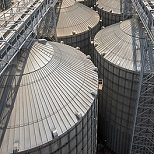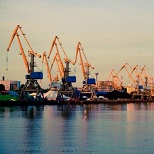A step in the right direction
For years, it has been the worst-kept secret for any foreign investor that port concession tender conditions in Ukraine were often drafted to single out one particular winning party. However, these days one can feel a change in the air. Lawmakers are now focused on increasing the competitiveness of the country’s port industry. As such, the new legislation on port concessions is aimed at attracting big time concessionaires to settle in Ukrainian ports.
he draft includes a lot of new proposals, which, when effectively put into use, will benefit the investor and the concessionaire, the port authorities, as well as trade and the econ- omy. Specifically, six amendments stand out.
The essential steps
First, simplifying both the procedure of transferring the object into concession and the procedure of holding the con- cession tender. A tender is to consist of four stages: preliminary selection of the candidates-concessionaires; submission of tender bids by the participants; assessment of tender bids and selection of the best proposal; and finally, negotiations with the winner.
Second, decisions made by the concessor will be regulated in order to eliminate the possibility of non-transparent decision- making. A concession tender announcement will be accepted and published by the concessor (principal provisions of such an announcement are prescribed directly by the new law). Jointly with the announcement, instruction for candidates will be placed on the concessor’s website (the instruction’s contents are also prescribed directly by the law); in particular, criteria of preliminary candidate selection and grounds for non- admission of a candidate to participate in the tender will also be published. Next, the concessor shall notify the candidates in writing on the previous qualification results, within five calendar days from the date of approving the conclusion on their admission/non-admission to participate in the bid.
Third, the procedure of submitting tender bids by the candidates is also prescribed in a clear way, so as to not make it any harder for potential investors to find their way through the complexities of Ukrainian legislation. It does not mean that foreign investors cannot ask local lawyers for advice on the specifications of the local legislation, only that law- makers want to make sure that interested parties don’t drop out of the tender before it even starts simply because they find the new bidding process too tangled up. Fourth, the tender bid assessment will consist of two stages: an evaluation of the technical aspects of the bid with regards to its compliance with the requirements; and a review of financial and economic aspects. The tender commission shall – within 30 calendar days until expiration of the term for tender bid submission and following the results of review and assessment of all the tender bids – come to and approve the conclusion upon determining the best terms for concession, stating the assessment results regarding all the tender bids and determining the tender proposal with the highest score. Such conclusion should be considered and approved by the concessor within five days, followed by negotiations aimed at discussing, drafting, and concluding the concession agreement.
Fifth, the new law also provides an opportunity to form a concession object at the expense of property kept on the balance of several balance holders, jointly with an opportunity to initiate concession projects by the investor itself. In this context, the Ukrainian port operators have also welcomed another innovation, namely an option to transform a lease relationship into a concession. Finally, the sixth point, the new law will also provide with an opportunity to replace the concessionaire.
Objective effectiveness
Among the key issues to be discussed, there is a clause (Part 3, Article 2) which differentiates a concession relationship from a public-private partnership (PPP). For instance, the right to transform the legal relationship into concession is being highly criticized, despite the fact that it became obvious that today’s lease relationship in the Ukrainian port sector has become ineffective and even counterproductive. In our opinion, this discussion will be over when large and effective business groups replace today lessees.
Since the draft has been subjected to the first reading, it is plausible to assume that during the preparations for the second reading, and within a clause-by-clause discussion, the legislator will iron out the effective- ness criteria in respect to lease relationship. Confronted with an objective benchmark, the lessee will either have to transform the relationship or engage in a tender, in both cases to ultimately prove its solvency. Certainly, the implementation of such an objective effectiveness criteria in respect to lease relationship will mitigate the potential corruption risk typical of direct negotiations, i.e., talks on concluding the concession agreement without a tender.
Towards the next level of partnership
Although the draft initially received high expert praise in Ukraine, it can be further improved by, i.a., clarifying the technical aspects. Nevertheless, there’s no doubt that the obtained path is the right one. For the first time, it seems, the Ukrainian legislator is candidly concerned with the nuances of regulating concession relationship.
We may now only hope that the new wording of the law in question will facilitate further development of PPP and concession relationship, thus helping the country in its much needed and wanted progress. Ukraine is currently in what is called the second stage of developing PPPs and regulating concessions. This phase covers the establishment of bodies engaged in the methodological management of PPPs and drafting new con- cession models, as well as sourcing financial stimulation to level up a given industry. The next stage should deliver an increase in the number, scale, and life cycle of PPP projects; improvement of the legal specifications of PPP models; creation and development of risk management systems; engagement of non-industry specific investors, like pension funds; and upgrade of the PPP state management system in line with the standards of openness and transparency, managed by a professional team supplied through a proper PPP personnel training system.
The Ministry of Infrastructure of Ukraine, jointly with other ministries and authorities, has already implemented or will put in place agendas (e.g., the Pilot Office upon PPP development) that will manage the PPP processes. Concession projects have been drafted by renowned international consultants. For instance, the concession project aimed at the development of the Olvia and Kherson seaports has been jointly prepared by the International Finance Corporation and Maritime & Transport Business Solutions, which only shows high interest of foreign (first of all, European) companies in investing in Ukrainian harbours.
If state authorities can assist private business by means of sound legislative initiatives, such synergy will only facilitate the development of the PPP model. This, in turn, will have a positive impact on the overall investment climate in Ukraine, not only the country’s port sector.
3-4/2018 | Baltic Transport Journal

Probing Virgin Ground: Worries of international consultants in Ukraine Ukraine’s long proclaimed struggle for the foreign direct inve...
.jpg)
Ukrainian Law on Inland Water Transport Finally in Force President of Ukraine Volodymyr Zelensky has signed the Law on In...

Feasibility study for the concession of the container terminal “Chornomorsk” ready in early 2021 The working Group on the implementation...
 November Transport, Shipping & Port News2020.12.04
November Transport, Shipping & Port News2020.12.04Dear Reader! Our monthly digest is confined to ports, terminals, shipping and transport of Ukraine. Ukrzaliznyts...

Ukraine as a littoral state commanding most of the Black Sea north coast along with the Azov Sea north occupies a strate...
 Opportunities in the Ukraine2019.07.10
Opportunities in the Ukraine2019.07.10At the moment there is a concession pilot project conforming to European norms under way for the public stevedoring companies in Olvia (form...
 Endgame or a Path to Possibilities?2019.05.24
Endgame or a Path to Possibilities?2019.05.24Ukrainian port industry is growing rapidly and the upcoming vote for concession legislation should only confirm this trend. ...

1. Who’s pushing? The acting Cabinet of Ministers led by Volodymyr Groisman initiated the draft law development in summer 2016. The EBRD...
 A step in the right direction2018.08.27
A step in the right direction2018.08.27For years, it has been the worst-kept secret for any foreign investor that port concession tender conditions in Ukraine were often drafted t...

Until recently, investing in Ukrainian port infrastructure was considered quite risky, due to an outdated regulatory framewor...




 Odessa, 65014, Ukraine, 1 а, Gretska St
Odessa, 65014, Ukraine, 1 а, Gretska St
